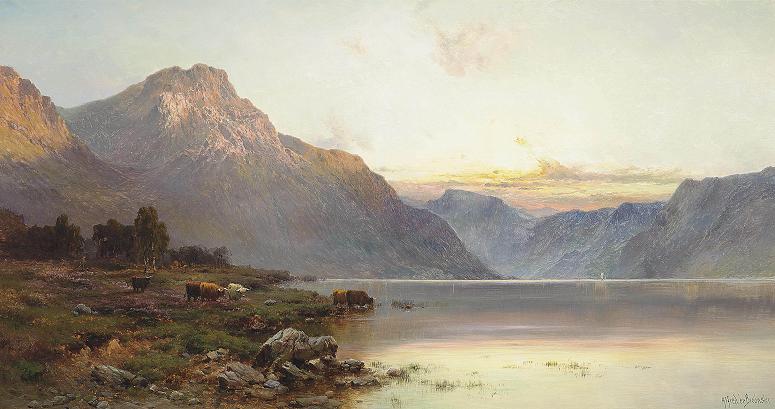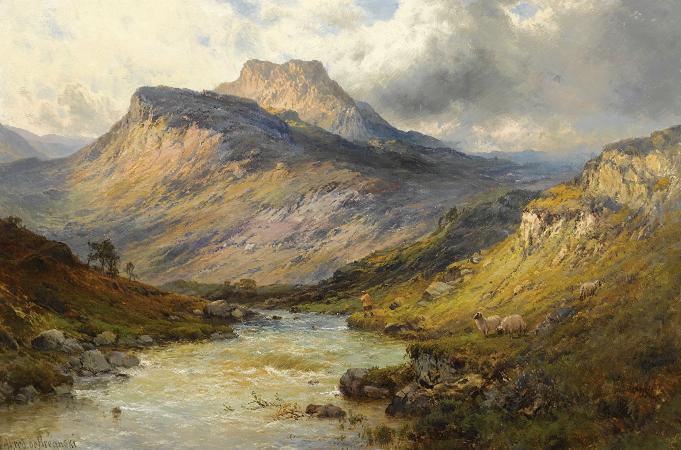Loch Lomond. Loch Lomond is a freshwater Scottish loch which crosses the Highland Boundary Fault, often considered the boundary between the lowlands of Central Scotland and the Highlands. Traditionally forming part of the boundary between the counties of Stirlingshire and Dunbartonshire, Loch Lomond is split between the council areas of Stirling, Argyll and Bute and West Dunbartonshire. Its southern shores are about 23 kilometres northwest of the centre of Glasgow, Scotland's largest city. The Loch forms part of the Loch Lomond and The Trossachs National Park which was established in 2002. Loch Lomond is 36.4 kilometres long and between 1 and 8 kilometres wide, with a surface area of 71 km 2. It is the largest lake in Great Britain by surface area; in the United Kingdom, it is surpassed only by Lough Neagh and Lough Erne in Northern Ireland. In the British Isles as a whole there are several larger loughs in the Republic of Ireland. The loch has a maximum depth of about 153 metres in the deeper northern portion, although the southern part of the loch rarely exceeds 30 metres in depth. The total volume of Loch Lomond is 2.6 km 3, making it the second largest lake in Great Britain, after Loch Ness, by water volume. The loch contains many islands, including Inchmurrin, the largest fresh-water island in the British Isles. Loch Lomond is a popular leisure destination and is featured in the song The Bonnie Banks o' Loch Lomond. The loch is surrounded by hills, including Ben Lomond on the eastern shore, which is 974 metres in height and the most southerly of the Scottish Munro peaks. A 2005 poll of Radio Times readers voted Loch Lomond as the sixth greatest natural wonder in Britain. The depression in which Loch Lomond lies was carved out by glaciers during the final stages of the last ice age, during a return to glacial conditions known as the Loch Lomond Readvance between 20,000 and 10,000 years ago. The loch lies on the Highland Boundary Fault, and the difference between the Highland and Lowland geology is reflected in the shape and character of the loch: in the north the glaciers dug a deep channel in the Highland schist, removing up to 600 m of bedrock to create a narrow, fjord-like finger lake. Further south the glaciers were able to spread across the softer Lowland sandstone, leading to a wider body of water that is rarely more than 30 m deep. In the period following the Loch Lomond Readvance the sea level rose, and for several periods Loch Lomond was connected to the sea, with shorelines identified at 13, 12 and 9 metres above sea level. The change in rock type can be clearly seen at several points around the loch, as it runs across the islands of Inchmurrin, Creinch, Torrinch and Inchcailloch and over the ridge of Conic Hill. To the south lie green fields and cultivated land; to the north, mountains. The loch contains thirty or more other islands, depending on the water level. Several of them are large by the standards of British bodies of freshwater. Inchmurrin, for example, is the largest island in a body of freshwater in the British Isles. Many of the islands are the remains of harder rocks that withstood the passing of the glaciers; however, as in Loch Tay, several of the islands appear to be crannogs, artificial islands built in prehistoric periods. English travel writer, H.V. Morton wrote: What a large part of Loch Lomond's beauty is due to its islands, those beautiful green tangled islands, that lie like jewels upon its surface. Writing some 150 years earlier than Morton, Samuel Johnson had however been less impressed by Loch Lomond's islands, writing: But as it is, the islets, which court the gazer at a distance, disgust him at his approach, when he finds, instead of soft lawns and shady thickets, nothing more than uncultivated ruggedness; Johnson Powan are one of the commonest fish species in the loch, which has more species of fish than any other loch in Scotland, including lamprey, lampern, brook trout, perch, loach, common roach and flounder. The river lamprey of Loch Lomond display an unusual behavioural trait not seen elsewhere in Britain: unlike other populations, in which young hatch in rivers before migrating to the sea, the river lamprey here remain in freshwater all their lives, hatching in the Endrick Water and migrating into the loch as adults.
more...





